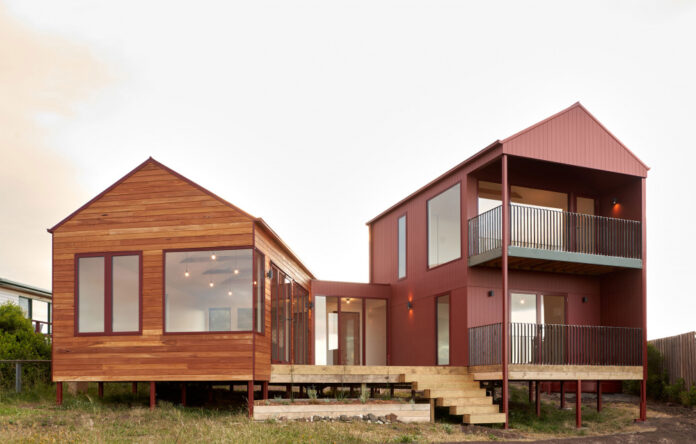[ad_1]
A Modest Contemporary Home Inspired By Classic Tasmanian Shacks
Sustainable Homes

House in Tasmania, aka Big Red, is a new, small dwelling conceived as a contemporary interpretation of an Australian shack. Photo – Max Combi

The compact house is less than 90 square metres and is designed to capitalise on the beautiful site aspects and views. Photo – Max Combi

One of the two pavilions is clad in blackbutt hardwood. Photo – Max Combi

Internal materials and finishes are modest yet suited to the client’s taste. Photo – Max Combi

Flat pack formply joinery was put together on site by the clients. Photo – Max Combi

Various artworks by Lucienne Rickard, Joel Crosswell, Jo White, Robert O’Connor, and Heather B Swann. Photo – Max Combi

The single-storey pavilion contains the kitchen, dining and lounge space. Various artworks by Lucienne Rickard, Joel Crosswell, Jo White, Robert O’Connor, and Heather B Swann. Photo – Max Combi

The two storey-volume houses the two bedrooms and two bathrooms. Photo – Max Combi


Fibre cement cladding would never have been selected over hardwood if not to keep costs down, and yet this has arguably become the project’s defining asset. Photo – Max Combi

The central outdoor deck and walkway. Photo – Max Combi

The Colorbond roof in Manor Red is durable and typical to the homes of the area. Various artworks by Lucienne Rickard, Joel Crosswell, Jo White, Robert O’Connor, and Heather B Swann. Photo – Max Combi

The design captures two equally beautiful views: one towards kunanyi/Mt Wellington, and the other of Primrose Sands beach. Photo – Max Combi
‘Big Red’ is a new home very much grounded in its surroundings. The project by Architect George is a contemporary interpretation of an Australian shack, inspired by the vernacular of the modest homes in the coastal town of Primrose Sands, Tasmania.
The house spans two pavilions visually separated by an outdoor deck, creating 90 square metres of internal floor space. The reasons for this unorthodox and compact layout are threefold: to keep project costs down, suit the existing neighbourhood character, and provide prime outdoor space. The pavilions are deliberately ‘twisted’ to capture two equally beautiful views: one towards kunanyi/Mt Wellington, and the other to Primrose Sands beach. The single-storey pavilion contains the kitchen, dining and lounge space, while the two storey-volume houses the two bedrooms and two bathrooms.
‘By keeping the size of the home smaller, it allowed more of the spaces to enjoy these views and an improved connection to the outdoor garden spaces,’ says Dean Williams, director of Architect George. ‘[This strategy also] meant that we could do more with the budget. Better quality spaces, rather than larger ones.’
What Big Rid doesn’t do is equally as notable as what it does. The home does not attempt to position itself above the other houses in the area, but capitalise on the existing landscape to enrich the lives of residents.
Working with a modest budget is always a challenge, but in this case, Dean says it inspired the final outcome. Fibre cement cladding would never have been selected over hardwood if not to keep costs down, and yet this has arguably become the project’s defining asset.
‘We don’t shy away from the fact that the end result is far more unique and interesting as a result of overcoming budget constraints,’ says Dean. ‘We love the red two-storey pavilion and watching its colour tones change as the sun moves across the building throughout the day. It dances really nicely with the colours that you experience in the surrounding area.’
The Colorbond roof is durable and typical to the homes of the area, while blackbutt hardwood cladding on the single-storey pavilion will transform over time to a sympathetic pale grey. Internal materials and finishes are similarly modest yet suited to the client’s taste, including flat pack formply joinery they personally assembled together on site.
Other than being connected to town electricity, this house is also self-sufficient. Rainwater tanks collect valuable rainfall, and a septic system is installed on site.
What the clients love most about their home is its connection to the land and means of providing a sustainable lifestyle. They say, ‘The design of this house has meant that there is no separation between our day to day life and the local environment. The ability to observe the seasons, the weather, and local species from every space in the house means that a true sense of place is not only possible, but inevitable.’
[ad_2]
thedesignfiles.net










